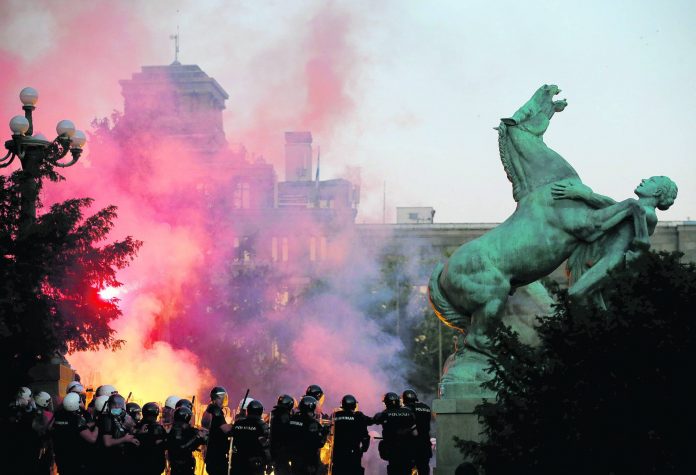
Hundreds of demonstrators tried to storm Serbia’s parliament on Friday, clashing with the police during for the fourth night of protests against the president’s increasingly authoritarian rule.
Demonstrators — who were defying a ban on mass gatherings amid a spike in virus infections — threw bottles, rocks and flares at the police guarding the domed parliament building in central Belgrade. Smoke rose above the entry stairway. Police used their shields to push back the protesters and prevent them from entering the building.
Some opposition leaders have said the violence was the work of demonstrators controlled by the government — with an aim to discredit the protests that began in response to President Aleksandar Vucic’s efforts to reimpose lockdown restrictions against the virus, but have mushroomed into an expression of wider frustration with his hard-line rule.
Vucic has denied that “hooligans,” who were seen beating up the peaceful protesters earlier this week, are under his control, claiming they were brought in by the opposition.
Speaking earlier Friday, Vucic said he’s not worried about losing political power amid the protests, considered the most intense since the overthrow of former Serbian strongman Slobodan Milosevic in 2000. He instead expressed his fear about the spread of the virus by the demonstrators.
“It is so irresponsible to call upon people to gather and demonstrate when we are faced with the most horrific numbers of infections from the coronavirus,” Vucic told reporters during his state visit to France.
“I beg people, please let’s keep our health safe. Nobody is going to take power by force. Power is taken at the elections. You can protest as much as you want when the epidemic is over,” he said.
On Friday, the Serbian prime minister announced the highest daily number of deaths, 18, since the start of the pandemic in the Balkan country. She said 386 new confirmed were recorded cases in the past 24 hours. That brings the total to over 17,300 confirmed cases and 352 deaths since March.
Friday’s unrest came after a peaceful protest on Thursday — though there was also violence earlier this week.
The protests started on Tuesday when Vucic announced that Belgrade would be placed under a new three-day lockdown following a second wave of confirmed coronavirus infections. They have continued even though Vucic suspended his plans to enforce the lockdown. Instead his government has banned gatherings of more than 10 people in the capital.
After initially handling the pandemic relatively well, Vucic and his government have been accused of allowing the crisis to spin out of control in order to hold a June 21 election that tightened his grip on power.
Opponents blame the president for contributing to the large spike in deaths and new cases after he entirely lifted previous very tight lockdown measures. Mass gatherings at soccer and tennis matches and at nightclubs were allowed despite warnings by experts that this could lead to a spike in infections.
Serbian officials denounced the protests as an attempt to overthrow the government and weaken Vucic’s position in the European Union-mediated negotiations on Kosovo, a former province whose 2008 declaration of independence Belgrade doesn’t recognize.



















